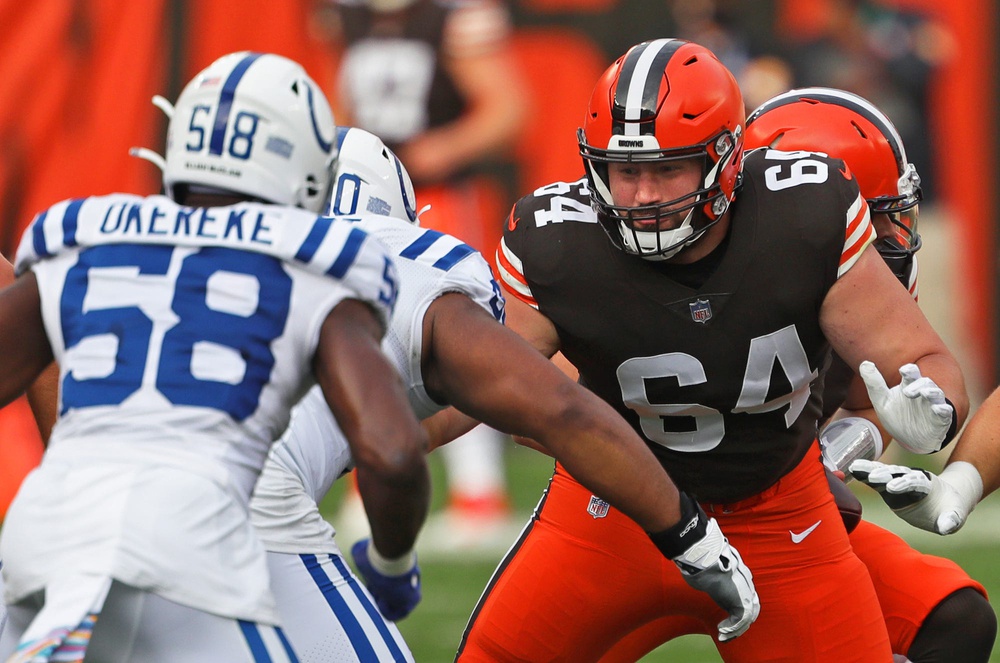- Joined
- May 8, 2014
- Messages
- 39,708


2024 Los Angeles Rams Cap Table
The Los Angeles Rams 2024 salary cap table, including team cap space, dead cap figures, and complete breakdowns of player cap hits, salaries, and bonuses.






A board favorite:
43. TE DAVID NJOKU, CLEVELAND BROWNS
Njoku has been on quite the journey from his first-round selection in 2017 to finally reaching free agency, but along the way, he has made several spectacular plays that demonstrate the rare athleticism that made him a top draft pick. Some minor injuries and trade requests throughout his time in Cleveland have distracted from what has been a strong start to a career at a position that tends to take a while to learn.
Two of the game's best tight ends in the Baltimore Ravens’ Mark Andrews and the Philadelphia Eagles’ Dallas Goedert agreed to top-of-market, early extensions during the 2021 season, and Njoku is younger than both of them despite leaving college a year earlier. This, coupled with Njoku earning a career-high 70.9 grade in 2021 could lead to a free-agent deal that resembles the one signed by New England Patriots tight end Hunter Henry.
Strengths:
– YAC
– Athleticism
Weaknesses:
– Consistency
– Weaker blocker than receiver
Scheme Fit/Role:
STARTING TE: A former first-round pick, Njoku has never quite been as productive as his talent suggests he should have been, but he possesses the skill set to put it all together. Even his blocking — a weakness earlier in his career — has consistently improved, and he could be primed for a breakout role with more focus on him for a new team.
Recent Injury History:
Njoku suffered a wrist injury in 2020 that caused him to miss much of the season but has been largely healthy in 2021.
Contract Projection: Three years, $37.5 million ($12.5M per year, $25.5M total guaranteed)
Bottom Line:
Njoku is a dynamic athlete who can be impressive with the ball in his hands, and he has improved in all areas of his game. His early-career performance saw him slip in the pecking order within the Browns' offense, but he could be ready to assume a greater role again in a new environment.



That has been their approach for sure. So adding to the pipeline is likely.I fear the Rams will stand pat with the offensive line again and coach up whoever they have in-house to replace departures. And use mid to late round picks to find depth and succession plan 2-3 years out as those guys get groomed as well.
The Rams seem to believe this approach will suffice for the o-line, as they seek play makers elsewhere.
And after just winning a Super Bowl, they might be right!
But how often can you rely on your defence to completely dominate like ours did last night? How often will you face an o-line as weak as the Bengals' unit in the Super Bowl, to allow that to happen in the first place?
We could not run the ball at all last night. That is a huge problem.
Offensive line and corner are my top two priorities to improve with whatever cap room we have as well as the draft. David Long came on with quantum leaps. And I like what I have seen from Rochell. Maybe they become high level starts but who knows. Williams took a big step back. Not everyone can be a Pro Bowler in a cap world, but it still feels like we only have 1 truly trustworthy CB in Ramsey. Not good enough in today's NFL.


You can bid all you want. The player has to think that's the spot for him too though. And there are some good teams that will want Armstead that's for sure so yeah I think setting yourself up to go get him requires that you have an in-house fallback you are good with.Cincy has a ton of cap space.. if I’m them, no one outbids me for Armistead.
Some offensive skill position thoughts...
QB
Stafford: contract will be redone to help with cap, probably a big time deal with heavy back end. Congrats 9!
Wolford: Likely to be in first round of cuts. Thanks for the memories Wolf.
Perkins: Legs off the bench with some calmness in his game. 2022 backup QB with two years of cheap team control.
Positional outlook: good to go for two years before backup must be addressed.
RB
Akers: still the future and under good team control.
Henderson: change of pace and third down back with team control.
Funk: core teamer type, injury risk and somewhat limited physically but with plenty of team control.
Jones: needs to become core teamer to stick on this roster.
Calais: like with Jones two years of control but probably will be squeezed off the roster.
Positional outlook: Rams need a guy who can stay healthy and eat snaps. A power type would be perfect. Michel would be sufficient in that role if they keep him but draft makes sense here since you can find RBs deep into most drafts to include this one.
WR
Kupp: guessing they may redo his deal but he earns that high cap hit so either way he's good.
Woods: there is a chance he will be traded this offseason. Rams need to reload this WR group with guys who benefit the QB he & Kupp are redundant.
Jefferson: good young wideout under team control. Not a great fit schematically but valuable and affordable.
Atwell: there's always room for a speedy waterbug in an offense if he can dedicate himself and improve. He likely has time barring a situation where he rubbed the boss the wrong way.
Skowronek: core teams type, did a good job in fullback role in the playoffs, cheap and team control.
Harris: started fast then got hurt, I think the reason they consider him a WR now is his weight and the way he gets tossed around by DBs, so if he's gonna try to be a TE he would need a big workout offseason with weight gaining. But for now he's like Skow a strong gunner/teams guy who will get his hands dirty but the difference with Harris is he has explosive speed.
Positional outlook: likely that they bring Beckham back now I think, given the injury. McVay might want to do more to retool this group around Stafford but it's gonna have to be a little at a time and OBJ is a good start with those hands and contested catch ability that is ideal. Not sure if they can rework Woody's deal or if he'd be open to that, but there is potential for a move there with him.
TE
Higbee: relative bargain and all around excellent TE with two years of control.
Hopkins: will get a chance to compete for a TE2 job this next camp, two years of control.
Blanton: see above, will compete with Hopkins, also good team control.
Positional outlook: Rams need some fresh blood at TE. If the Rams really like Hopkins/Blanton competition to produce TE2 they just need a depth/pipeline guy. Otherwise a FA addition is possible since drafted options will take some time with this position.



And Bates gets franchise tagged so he stays as well.Cincy has a ton of cap space.. if I’m them, no one outbids me for Armistead.
